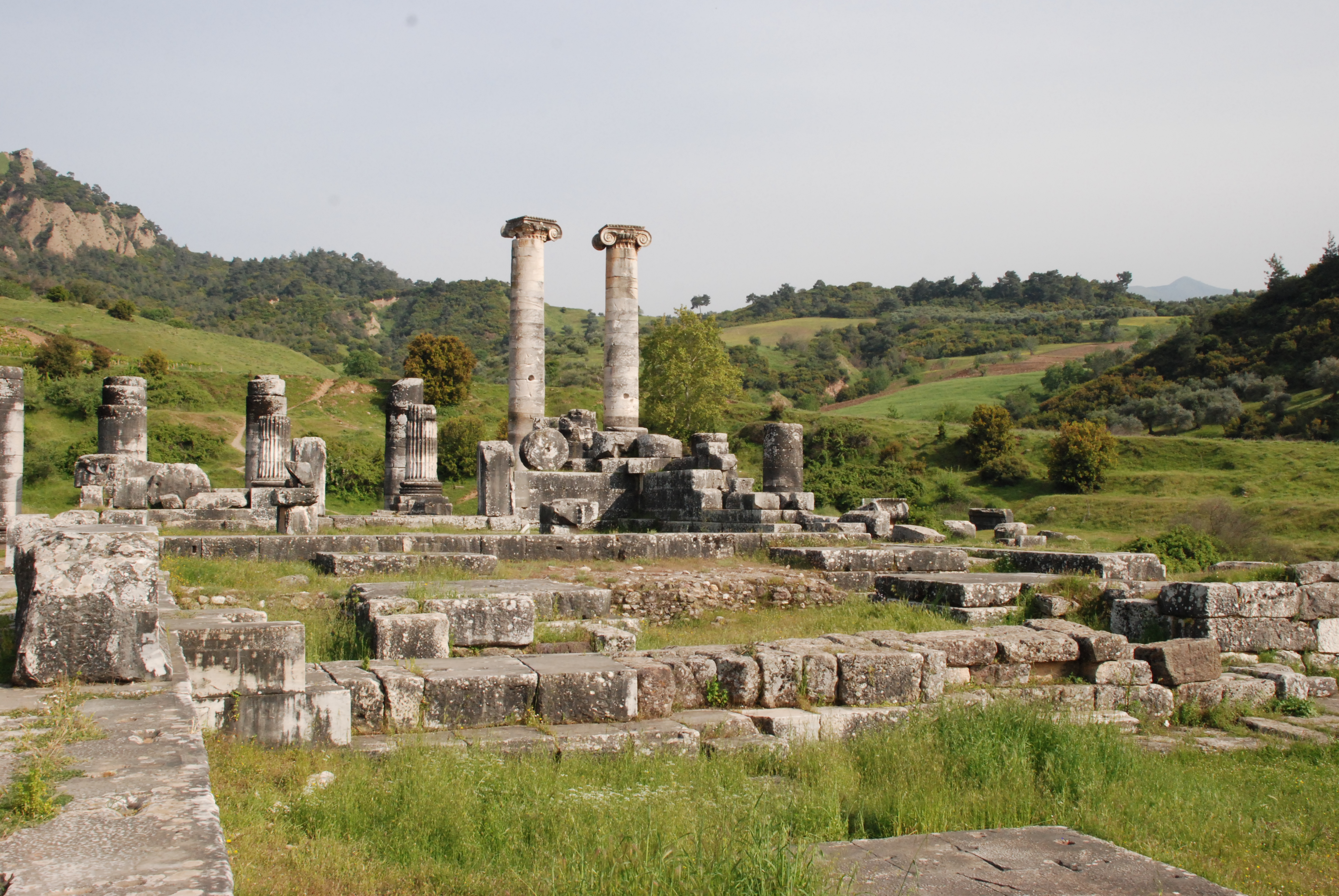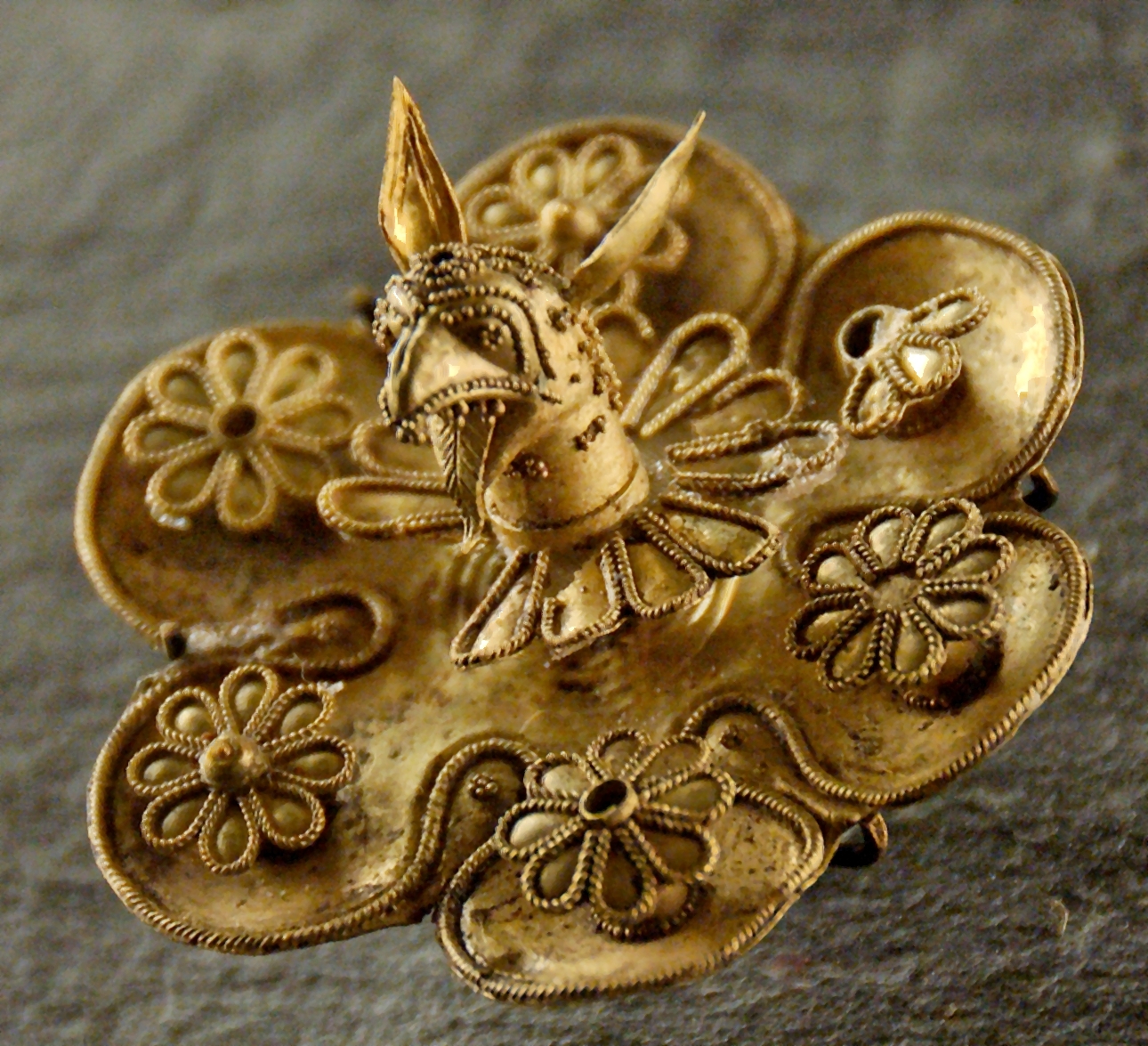|
Alyattes Of Lydia
Alyattes (Lydian language: ; ; reigned c. 635 – c. 585 BC), sometimes described as Alyattes I, was the fourth king of the Mermnad dynasty in Lydia, the son of Sadyattes, grandson of Ardys, and great-grandson of Gyges. He died after a reign of 57 years and was succeeded by his son Croesus. Alyattes was the first monarch who issued coins, made from electrum (and his successor Croesus was the first to issue gold coins). Alyattes is therefore sometimes mentioned as the originator of coinage, or of currency. Name The most likely etymology for the name derives it, via a form with initial digamma (), itself originally from a Lydian ( Lydian alphabet: ). The name meant "lion-ness" (i.e. the state of being a lion), and was composed of the Lydian term (), meaning "lion", to which was added an abstract suffix (). Chronology Dates for the Mermnad kings are uncertain and are based on a computation by J. B. Bury and Russell Meiggs (1975) who estimated c.687–c.652 BC for ... [...More Info...] [...Related Items...] OR: [Wikipedia] [Google] [Baidu] |
Lydia
Lydia (; ) was an Iron Age Monarchy, kingdom situated in western Anatolia, in modern-day Turkey. Later, it became an important province of the Achaemenid Empire and then the Roman Empire. Its capital was Sardis. At some point before 800 BC, the Lydian people achieved some sort of political cohesion, and existed as an independent kingdom by the 600s BC. At its greatest extent, during the 7th century BC, it covered all of western Anatolia. In 546 BC, it became a Lydia (satrapy), satrapy of the Achaemenid Empire, known as ''Sparda'' in Old Persian. In 133 BC, it became part of the Roman Republic, Roman Asia (Roman province), province of Asia. Lydian coins, made of electrum, are among the oldest in existence, dated to around the 7th century BC. Geography Lydia is generally located east of ancient Ionia in the modern western Turkish provinces of Uşak Province, Uşak, Manisa Province, Manisa and inland İzmir Province, İzmir.Rhodes, P.J. ''A History of the Classical Greek ... [...More Info...] [...Related Items...] OR: [Wikipedia] [Google] [Baidu] |
Currency
A currency is a standardization of money in any form, in use or circulation as a medium of exchange, for example banknotes and coins. A more general definition is that a currency is a ''system of money'' in common use within a specific environment over time, especially for people in a nation state. Under this definition, the British Pound sterling (£), euros (€), Japanese yen (¥), and U.S. dollars (US$) are examples of (government-issued) fiat currencies. Currencies may act as stores of value and be traded between nations in foreign exchange markets, which determine the relative values of the different currencies. Currencies in this sense are either chosen by users or decreed by governments, and each type has limited boundaries of acceptance; i.e., legal tender laws may require a particular unit of account for payments to government agencies. Other definitions of the term ''currency'' appear in the respective synonymous articles: banknote, coin, and money. Th ... [...More Info...] [...Related Items...] OR: [Wikipedia] [Google] [Baidu] |
Western Asia
West Asia (also called Western Asia or Southwest Asia) is the westernmost region of Asia. As defined by most academics, UN bodies and other institutions, the subregion consists of Anatolia, the Arabian Peninsula, Iran, Mesopotamia, the Armenian highlands, the Levant, the island of Cyprus, the Sinai Peninsula and the South Caucasus. The region is separated from Africa by the Isthmus of Suez in Egypt, and separated from Europe by the waterways of the Turkish Straits and the watershed of the Greater Caucasus. Central Asia lies to its northeast, while South Asia lies to its east. Twelve seas surround the region (clockwise): the Aegean Sea, the Sea of Marmara, the Black Sea, the Caspian Sea, the Persian Gulf, the Gulf of Oman, the Arabian Sea, the Gulf of Aden, the Red Sea, the Gulf of Aqaba, the Gulf of Suez, and the Mediterranean Sea. West Asia contains the majority of the similarly defined Middle East. The ''Middle East'' is a political term invented by Western geographers that has ... [...More Info...] [...Related Items...] OR: [Wikipedia] [Google] [Baidu] |
Eurasian Steppe
The Eurasian Steppe, also called the Great Steppe or The Steppes, is the vast steppe ecoregion of Eurasia in the temperate grasslands, savannas and shrublands biome. It stretches through Manchuria, Mongolia, Xinjiang, Kazakhstan, Siberia, European Russia, Ukraine, Moldova, Romania, Bulgaria, Hungary and Slovakia. Since the Paleolithic, Paleolithic age, the Steppe Route has been the main overland route between Eastern Europe, North Asia, Central Asia and East Asia economically, politically, and culturally. The Steppe route is a predecessor not only of the Silk Road, which developed during Classical antiquity, antiquity and the Middle Ages, but also of the Eurasian Land Bridge in the modern era. It has been home to nomadic empires and many large tribal confederations and ancient states throughout history, such as the Xiongnu, Scythia, Cimmerians, Cimmeria, Sarmatians, Sarmatia, Hunnic Empire, Sogdia, Xianbei, Mongol Empire, Magyar tribes, and Göktürk Khaganate. Geography Divisi ... [...More Info...] [...Related Items...] OR: [Wikipedia] [Google] [Baidu] |
University Of Liège
The University of Liège (), or ULiège, is a major public university of the French Community of Belgium founded in 1817 and based in Liège, Wallonia, Belgium. Its official language is French (language), French. History The university was founded in 1817 by William I of the Netherlands, then King of the United Kingdom of the Netherlands, and by his Minister of Education, Anton Reinhard Falck. The foundation of the university was the result of a long intellectual tradition which dates back to the origins of the Prince-Bishopric of Liège. Beginning in the eleventh century, the influence of the principality attracted students and prominent scientists and philosophers, such as Petrarch, to study in its libraries. The reputation of its medieval schools gave the city the reputation as Athens#Cities nicknamed "Athens", a new Athens. A 17 March 1808 decree by Napoleon I of France, Napoleon I concerning the organization of an imperial university indicated Liège as the site of a new ac ... [...More Info...] [...Related Items...] OR: [Wikipedia] [Google] [Baidu] |
Neo-Assyrian Empire
The Neo-Assyrian Empire was the fourth and penultimate stage of ancient Assyrian history. Beginning with the accession of Adad-nirari II in 911 BC, the Neo-Assyrian Empire grew to dominate the ancient Near East and parts of South Caucasus, North Africa and East Mediterranean throughout much of the 9th to 7th centuries BC, becoming the List of largest empires, largest empire in history up to that point. Because of its geopolitical dominance and ideology based in world domination, the Neo-Assyrian Empire has been described as the first world empire in history. It influenced other empires of the ancient world culturally, administratively, and militarily, including the Neo-Babylonian Empire, Neo-Babylonians, the Achaemenid dynasty, Achaemenids, and the Seleucid Empire, Seleucids. At its height, the empire was the strongest military power in the world and ruled over all of Mesopotamia, the Levant and Egypt, as well as parts of Anatolia, Arabian Peninsula, Arabia and modern-day Ir ... [...More Info...] [...Related Items...] OR: [Wikipedia] [Google] [Baidu] |
Cyrus The Great
Cyrus II of Persia ( ; 530 BC), commonly known as Cyrus the Great, was the founder of the Achaemenid Empire. Achaemenid dynasty (i. The clan and dynasty) Hailing from Persis, he brought the Achaemenid dynasty to power by defeating the Median Empire and embracing all of the previous civilized states of the ancient Near East, expanding vastly across most of West Asia and much of Central Asia to create what would soon become the List of largest empires#Timeline of largest empires at the time, largest empire in history at the time. The Achaemenid Empire's greatest territorial extent was achieved under Darius the Great, whose rule stretched from Southeast Europe in the west to the Indus Valley in the east. After absorbing the Median Empire, Cyrus conquered Lydia and eventually the Neo-Babylonian Empire, granting him control of Anatolia and the Fertile Crescent, respectively. He also led a major expedition into Central Asia, where his army brought "into subjection every nation wit ... [...More Info...] [...Related Items...] OR: [Wikipedia] [Google] [Baidu] |
Cimmerians
The Cimmerians were an Ancient Iranian peoples, ancient Eastern Iranian languages, Eastern Iranian peoples, Iranic Eurasian nomads, equestrian nomadic people originating in the Pontic–Caspian steppe, part of whom subsequently migrated into West Asia. Although the Cimmerians were Scythian cultures, culturally Scythian, they formed an ethnic unit separate from the Scythians proper, to whom the Cimmerians were related and who displaced and replaced the Cimmerians.: "As the Cimmerians cannot be differentiated archeologically from the Scythians, it is possible to speculate about their Iranian origins. In the Neo-Babylonian texts (according to D’yakonov, including at least some of the Assyrian texts in Babylonian dialect) and similar forms designate the Scythians and Central Asian Saka, reflecting the perception among inhabitants of Mesopotamia that Cimmerians and Scythians represented a single cultural and economic group" The Cimmerians themselves left no written records, and m ... [...More Info...] [...Related Items...] OR: [Wikipedia] [Google] [Baidu] |
Russell Meiggs
Russell Meiggs (20 October 1902 – 24 June 1989) was a British ancient historian. He did extensive research on the Roman port city of Ostia. Early life and education Meiggs was born at Balham, south London, son of William Herrick Meiggs (1866–1939), sometime self-styled "general merchant" declared bankrupt in 1916, and his wife Mary Gertrude (née May). The former success of the Meiggs family was diminished by the time Russell Meiggs was born; his grandfather "died almost destitute" after political developments in Argentina ruined a business venture, and William Meiggs, being the fourth son, had to make his own way in the world. He had eloped with Mary to Argentina in 1897, their first child, Helen, being born at Buenos Aires in 1898. The family settled in London, but William left the family, subsequently going to Argentina and elsewhere, with Meiggs "as a child... led to believe his father was dead"; despite William surviving until 1939, "Russell felt no obligation toward hi ... [...More Info...] [...Related Items...] OR: [Wikipedia] [Google] [Baidu] |
Electrum Trite, Alyattes II, Lydia, 610-560 BC
Electrum is a naturally occurring alloy of gold and silver, with trace amounts of copper and other metals. Its color ranges from pale to bright yellow, depending on the proportions of gold and silver. It has been produced artificially and is also known as " green gold".Emsley, John (2003Nature's building blocks: an A–Z guide to the elements Oxford University Press. p. 168. . Electrum was used as early as the third millennium BC in the Old Kingdom of Egypt, sometimes as an exterior coating to the pyramidia atop ancient Egyptian pyramids and obelisks. It was also used in the making of ancient drinking vessels. The first known metal coins made were of electrum, dating back to the end of the 7th century or the beginning of the 6th century BC. Etymology The name ''electrum'' is the Latinized form of the Greek word ἤλεκτρον (''ḗlektron''), mentioned in the ''Odyssey'', referring to a metallic substance consisting of gold alloyed with silver. The same word was also u ... [...More Info...] [...Related Items...] OR: [Wikipedia] [Google] [Baidu] |







